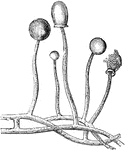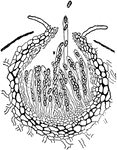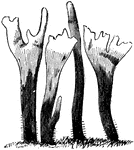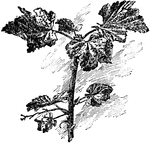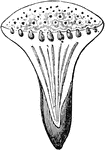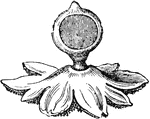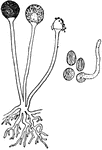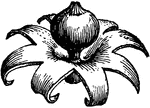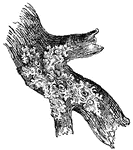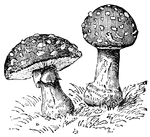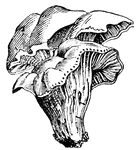
Adult Amanita
"Amanita is a genus of fungi, nearly allied to the mushrooms. Several of the species are edible, notably…
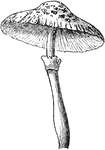
Agaricus cepaestipes
Agaricus cepaestipes is a mushroom from a large genus with both edible and poisonous species.

Protococcus Algae
"a genus of algae. P.nivalis (red-snow) appears on the surface of snow, tinging extensive tracts in…
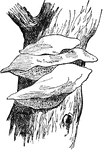
Amadou
"A name given to Polyporus igniarius and P. fomentarius, fungi of the tribe or division Hymenomycetes,…

Microscopic view of a fermented apple
"Portions of the rotting pulp were placed on a microscopic slide, divided into hundredths and thousandths…

Arcyria flava
Arcyria flava (or Arcyria obvelata) is a species of fungus or slime mold found in Australia.
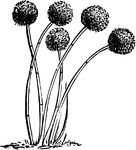
Aspergillus Glaucus
A genus of Mucedines (Hyphomycetous fungi) forming common molds, such as the blue of cheese. Aspergillus…
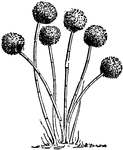
Aspergillus Glaucus
A genus of Mucedines (Hyphomycetous fungi) forming common molds, such as the blue of cheese. Aspergillus…
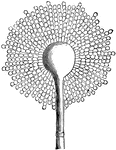
Aspergillus Glaucus
A genus of Mucedines (Hyphomycetous fungi) forming common molds, such as the blue of cheese. Aspergillus…
Aspergillus Glaucus
A genus of Mucedines (Hyphomycetous fungi) forming common molds, such as the blue of cheese. Aspergillus…

Bark of Pinus Sylvestris Invaded by Peridermium Pini
Illustrated is the bark of pinus sylvestris invaded by peridermium pini. A represents young peridia…

Willow Canker
"Scleroderris fuliginosa. a, immature ascocarps ... S. fuliginosa is said to be parasitic on twigs and…
Willow Canker
"Scleroderris fuliginosa. b, ascus containing spores and accompanied by paraphyses ... S. fuliginosa…

Cordycep
The Sphaeria sinensis a cordycep, a parasitic fungus. "The right hand figure represents the manner in…

Cordycep
The Sphaeria Robertsii a cordycep, a parasitic fungus "growing from the caterpillar of a New Zealand…

Fungal Disease
Vermicularia trichella is a fungal plant disease that causes leaf and stem spot in English Ivy.
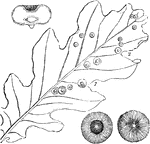
Fungal Diseas
"Mucor mucedo, very highly magnified, exhibiting 1, the spawn or mycelium." -Lindley, 1853

Dry Rot Fungus
Dry-rot fungus (Merulius lacrymans). A decay affecting timber, occasioned by various species of fungi,…
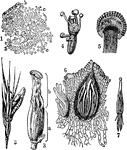
Ergot
"1. Cross-section of the ovary (sphacelia), in the early stage of the fungus, showing the mycelium (a…

Flocci and Spores
"1. Polyplocium inquinans, divided vertically, natural size; 2. flocci and spores; 3 and 4, the same…
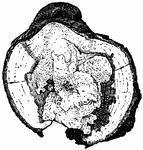
Fomes Igniarius Infected Maple Limb
Pictured is the cross section of a maple limb affected by Fomes igniarius. A young spore is shown as…
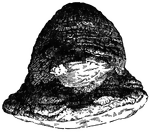
Nirgricans Variety of Fomes Igniarius
Fomes igniarius is a shelf fungus that causes the white heart-rot of deciduous trees. Pictured is the…

Fungi
"These may be placed at the very bottom of the vegetable scale, and are observable in a great variety…
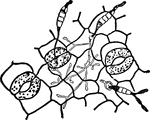
Fungi
"In general, fungi are low plants which do not contain chlorophyll, in contrast with the algae, which…

Fungus
"Pisomyxa racodioides, Corda.-1. Natural size; 2, the fungus greatly magnified; 3, a spore-case bursting…
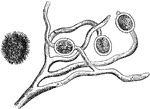
Fungus
Illustration of a fungus named Atrotogus hydnosporus. "Considered by Berkeley and others to be probably…

Stages of fungus growth
This illustration "represents its mycelium growth; 2,2 its budding cells, which terminate in fruit cells;…
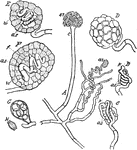
Eurotium Fungus
"Eurotium repens. A, a small portion of the mycelium with a conidiophore (c), terminated by the sterigmata…

Blight of Grapes
Illustrated is a blight of grapes due to some constitutional disorder. The leaves die first at the edges.

Pleospora Herbarum
An image depicting a Pleospora herbarum in macrospore stage. A, Conidium on Stalk; b, Conidium after…

Juniper Twig Attacked by Gymnosporangium
Gymnosporangium fuscum is a fungus that induces a thickened state of the branches of its host.
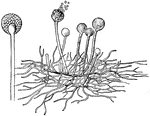
Common Mold
"Showing One of the More Common Molds found on Fruits and Bread. The tiny stalks grow verticallyinto…
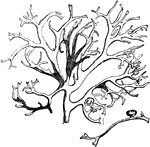
Tree Moss Bearing an Apothecium
The tree moss (Psuedevernia furfuracea) is a fungus that grows on the bark of firs and pines, here showing…

Mucor caninus
Mucor caninus is a species of mold found in soil, on plant surfaces, and rotting vegetables.
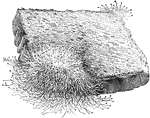
Mucor, a Common Mold
"A Piece of Bread upon which One of the Common Molds, known as Mucor, is growing." — Blaisedell,…


